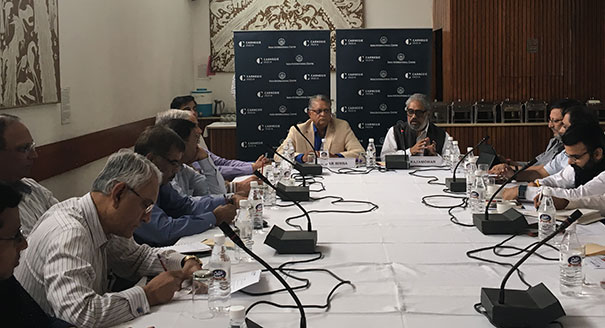Registration
You will receive an email confirming your registration.
In a speech at Fort Myers, President Trump put forward his administration’s Afghanistan strategy, in which he highlighted a greater role for India. Although New Delhi welcomed this move, its geopolitical implications must be considered in India’s approach to Afghanistan. Carnegie India, in association with the India International Center, hosted Amar Sinha, former Indian ambassador to Afghanistan, for a private roundtable discussion to assess New Delhi’s policy and programmatic responses to President Trump’s invitation to its northwestern neighborhood.
DISCUSSION HIGHLIGHTS
- Shifts in President Trump’s Afghanistan Strategy: Participants discussed key changes to the new U.S. strategy in Afghanistan[E1] that were outlined in President Trump’s speech. They argued that, in addition to inviting India to play a greater role, especially in terms of economic assistance, U.S. commitment in Afghanistan will be based on conditions in the theater as opposed to a time-based withdrawal. Participants also highlighted President Trump’s assertions against terror sanctuaries on Pakistani territory, and the Afghan Taliban.
- Opportunities for Indo-Afghani Cooperation: All participants agreed that India should boost political, economic, military engagement, as well as people-to-people contact with Afghanistan. Participants debated the option of investing in large-scale infrastructural projects, given Afghanistan’s volatile security situation. Some participants recommended pursuing capacity-building projects through partnerships with multilateral organziations such as the United Nations. Others specified that India could support the development of Afghanistan’s underutilized water resources. They then discussed prospects for Indo-Afghani security cooperation. India, they said, could support Afghanistan’s intelligence, surveillance, and reconnaissance capabilities. For example, participants said, equipping the Afghan National Security Forces could be pursued through a trilateral arrangement between India, United States, and Afghanistan. Participants disagreed on the idea of deploying Indian troops—in a combat, training, or advisory capacity—to Afghanistan. Finally, participants signaled that Afghanis believe India is choosing sides in the conflict. They recommended, therefore, that India must ensure that it is engaging the entire spectrum of Afghanistan’s population when assisting state-building efforts.
- Geographical Limitations: Participants highlighted the fact that geographical constraints challenge the scope of India’s engagement in Afghanistan. The lack of a common border, they argued, limited India’s influence and its role in the country. To overcome this, participants suggested increasing India’s political and economic assets in Afghanistan and utilizing the recently inaugurated Indo-Afghani air corridor.
- The Pakistan Dilemma: Participants cautioned that the U.S. policy in Afghanistan may continue to vacillate, either due to domestic pressures or a recalcitrant Pakistan. They highlighted U.S. dependence on Pakistan’s intelligence agency for counter-terrorism strategies and supply routes to transport provisions for U.S. soldiers in Afghanistan. Some participants suggested that India should publicly reassure Pakistan to collaborate in Afghanistan, while others recommended approaching Indo-Afghani relations independent of Pakistan. Participants also discussed China-Pakistan relations, arguing that it is likely to change if either Xinjiang or the China-Pakistan Economic Corridor (CPEC) were to become highly insecure.
- Engaging Regional Powers: Participants argued that India’s limited capacity to pursue a unilateral Afghan policy mean that regional partnerships are essential to realizing its goals. However, participants cautioned against tipping toward overdependence on U.S. commitments in Afghanistan. They said that in the interim leading up to President Trump’s speech on Afghanistan, China, Russia, and Iran started their own engagements in Afghanistan. Participants argued therefore that India must engage with Russia and Iran, as U.S. relations with the two nations remain uncertain. They added that India has extant ties with them, stemming from close consultations with Russia and Iran during the Taliban regime in Afghanistan. Moreover, all three states supported the Northern Alliance. Participants proposed that India can effectively engage Russia and Iran in developing regional connectivity via the Chabahar port, which can counter Chinese designs for regional connectivity, such as linking CPEC with Central Asia.
This event summary was prepared by Sharanya Rajiv, a program assistant at Carnegie India, with inputs from Sreeja Kundu and Neil Noronha, interns at Carnegie India.
